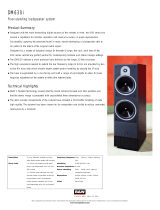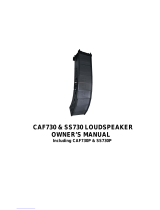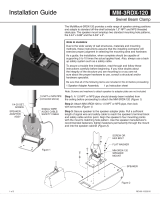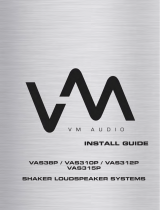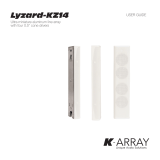Page is loading ...

TCS SERIES
USER MANUAL
Turbosound Ltd.
Star Road, Partridge Green
West Sussex RH13 8RY UK
Tel: +44 (0)1403 711447 Fax: +44 (0)1403 710155
web: www.turbosound.com
Issue 1.3 October 2005
Copyright © 2005 Turbosound Ltd
.

user manual
TCS series
tcs manual
page 2

user manual
TCS series
tcs manual
page 3
Contents
Thanks ................................................................................................................................5
Unpacking the TCS series loudspeaker...................................................................... 5
Introduction..................................................................................................................6
Features ........................................................................................................................6
Product Range Summary ............................................................................................ 7
System Requirements ............................................................................................... 10
Amplifier considerations ........................................................................................... 10
System Configurations..............................................................................................11
LMS-D6 Loudspeaker Management System................................................................. 13
Features ...................................................................................................................... 13
Loudspeaker Connections.........................................................................................14
Connecting Cables.....................................................................................................15
Flying and lifting..............................................................................................................15
Flying and lifting..............................................................................................................16
General .......................................................................................................................16
Flying single enclosures............................................................................................17
Installation of a single TCS series enclosure using eyebolts .................................20
Installation of a single TCS series enclosure using Turbosound or Omnimount
hardware.....................................................................................................................20
Installation of a single TCS series enclosure using WB-10, WB-20, W-55, CB-10,
CB-55 wall and ceiling brackets ................................................................................ 21
Installation of a single TCS series enclosure using SB-30 and SB-40 swivel
brackets.......................................................................................................................21
Rigging Instructions for a 2-wide TCS-56/59 array.................................................. 23
Rigging Instructions for a 2-wide TCS-56/59 array.................................................. 24
Rigging Instructions for a 3-wide TCS-56/59 array.................................................. 25
Rigging the TCS-40 with 3-wide TCS-56/59 arrays.................................................. 26
Appendix A ......................................................................................................................27
Technical Specifications............................................................................................ 27
Appendix B: Warranty.....................................................................................................29
Limited Warranty ....................................................................................................... 29
Warranty Coverage....................................................................................................29
Shipping .....................................................................................................................29

user manual
TCS series
tcs manual
page 4
Incidental and consequential damages................................................................... 30
Limitation of implied warranties .............................................................................. 30
Appendix C ......................................................................................................................31
Use of thread locking compounds ........................................................................... 31
Notes .......................................................................................................................... 32

user manual
TCS series
tcs manual
page 5
THANKS
Thank you for choosing a TURBOSOUND TCS series loudspeaker product for your
application. Please spare a little time to digest the contents of this manual, so that you
obtain the best possible performance from this unit.
All TURBOSOUND products are carefully engineered for world class performance and
reliability.
If you would like further information about this or any other TURBOSOUND product,
please contact us. Detailed product information is available on our web site at
www.turbosound.com
We look forward to helping you in the near future.
Unpacking the TCS series loudspeaker
After unpacking the unit please check carefully for damage. If damage is found, please
notify the carrier concerned at once. You, the consignee, must instigate any claim. Please
retain all packaging in case of future re-shipment.

user manual
TCS series
tcs manual
page 6
Introduction
Congratulations, you have just purchased a professional loudspeaker product from the
TCS Series sound contracting loudspeaker range, designed to give you the best in audio
quality and many years of reliable, trouble free operation. It offers excellent pattern
control, superior audio quality, integral rigging and flying hardware options, full technical
documentation including EASE data, and a comprehensive warranty against
manufacturing defects. Please read through this manual carefully before you attempt to
operate the loudspeaker system. It contains valuable information enabling you to quickly
and easily connect the loudspeakers to your amplifiers, important system and set-up
checks together with positioning and mounting instructions.
Features
♦ TCS series cabinets are constructed from high quality birch plywood; rebated, glued
and screwed together for maximum strength and rigidity.
♦ Internal rigging points enable a wide variety of installation methods: with standard
eyebolts; OmniMount hardware; and optional Turbosound wall and ceiling brackets.
♦ High quality components are used throughout the TCS range. Cast frame low
frequency drivers give the combined benefits of high strength and low weight, while
high frequency drivers are all selected for consistent and reliable performance.
♦ TCS series enclosures are supplied with a durable black textured paint finish as
standard. Optional finishes include TurboBlue™ and white textured paint, or raw
birch plywood for painting or staining on site to match venue décor requirements.
♦ Speakon NL4MP connectors and 4-way terminal strips are provided on a recessed
rear panel to allow for input and loop-through connections. Wedge monitors are
supplied with two Speakon NL4MP connectors for mobile use.
♦ TCS series full-range enclosures are designed to give good pattern control down to
crossover frequency, and are fully supported with EASE polar data (available to
download from the Turbosound web site at www.turbosound.com). This enables
accurate and predictable results when specifying sound systems in a given venue.

user manual
TCS series
tcs manual
page 7
Product Range Summary
The TCS-20 is a compact passive 2-way wide dispersion
loudspeaker using two 5” LF drivers and a 1” neodymium soft
dome HF tweeter for use in background and surround sound
applications ranging from multimedia and audio visual to retail
shopping malls. Its wide dispersion pattern of 120° by 120° makes
it ideal for distributed and surround sound applications. The
cabinet is fitted with M6 internal fixings for permanent
installations using eyebolts, OmniMount™ series 50 hardware or
optional Turbosound mounting brackets.
The TCS-30 is a passive 2-way enclosure offering wide dispersion quality audio for
theatre under-balcony and delay speaker applications. It uses two 5” LF drivers and a 100°
x 60° HF horn. The cabinet is fitted with M6 internal fixings for permanent installations
using standard eyebolts and optional Turbosound wall and ceiling brackets.

user manual
TCS series
tcs manual
page 8
The TCS-35 is a compact trapezoidal passive 2-way loudspeaker
with a single 8” LF driver and a 1” titanium HF tweeter. It is
designed for background sound applications in pubs, cafes, bars
and restaurants. The cabinet is fitted with M6 internal fixings for
permanent installations using optional OmniMount 75 series,
Powerdrive 75 series and Turbosound wall and ceiling brackets.
The TCS-40 is a passive 2-way loudspeaker
with 2 x 8" LF drivers and a 1" HF compression
driver on a 90° x 40° horn. It can either be used
as a downfill enclosure with TCS-56 or TCS-59
arrays, or in under-balcony or delay speaker
applications. The cabinet is fitted with M10 internal steel rigging points for permanent
installations using standard eyebolts or optional Turbosound wall and ceiling brackets.
The TCS-56 is a passive trapezoidal full range 2-way loudspeaker
with a 12" LF driver and a 1" HF compression driver on a 60° x 40°
constant directivity horn. Its controlled dispersion pattern makes
it ideal for use in main sound reinforcement arrays for houses of
worship and theatres. The HF horn can be rotated through 90°
enabling horizontal cabinet orientation. The cabinet is fitted with
M10 internal steel rigging points for permanent installations
using standard eyebolts or optional Turbosound wall and ceiling
brackets.
The TCS-59 is a passive trapezoidal full range 2-way loudspeaker
with a 12" LF driver and a 1" HF compression driver on a 90° x 60°
constant directivity horn. The wide dispersion pattern is ideal for
near field applications. The cabinet is fitted with M10 internal
steel rigging points for permanent installations using standard
eyebolts or optional Turbosound wall and ceiling brackets.

user manual
TCS series
tcs manual
page 9
The TCS-108 is a compact front loaded vented subwoofer
with a high efficiency 8” low frequency driver. Its design
allows multiple configurations adaptable to differing venue
requirements by assembling units together with the
supplied external brackets. The cabinet is fitted with M10
internal rigging points for permanent installations using
standard eyebolts. The TCS-108 is also available with
integral passive crossover network (TCS-108P), and as a
self-powered product with an internal power amplifier
module.
The TCS-118 is a 1200 watt front loaded vented subwoofer
using a high efficiency 4” voice coil 18" low frequency
driver. Internal cabinet reflections are minimised by virtue
of an angled speaker baffle. The cabinet is fitted with M10
internal steel rigging points for permanent installations
using standard eyebolts.
The TCS-215 is a front loaded 1600 watt subwoofer using
two high efficiency 3” voice coil 15" low frequency drivers
fitted to individual off-set speaker baffles to minimise
internal cabinet reflections. The cabinet is fitted with M10
internal steel rigging points for permanent installations
using standard eyebolts.
The TCS-12M is a front loaded 2-way passive wedge monitor for
vocal and music monitoring. It comprises a 12" low frequency driver
and a 1" high frequency compression driver on a 90° by 40° horn in
an optimally ported 42° enclosure.
The TCS-15M is a front loaded 2-way passive wedge monitor for
vocal and music monitoring. It comprises a 15" low frequency driver
and a 1" high frequency compression driver on a 90° by 40° horn in a
42° enclosure.

user manual
TCS series
tcs manual
page 10
System Requirements
TCS series 2-way enclosures are passive loudspeaker systems. This means that they
require only one amplifier channel for correct operation, the frequency splitting between
the low frequency driver and the high frequency driver being accomplished by the
internal passive crossover network in each enclosure. If subwoofer enclosures are used in
a bi-amplified system in conjunction with TCS series 2-way enclosures, additional
amplifier channels and external electronic crossovers will be required. Turbosound LMS
series digital management systems are recommended for this purpose.
Amplifier considerations
Turbosound loudspeaker enclosures should be driven by high quality power amplifiers
designed for true professional use. Such amplifiers will have balanced inputs, DC and RF
fault protection, and well designed cooling systems for reliability.
The program power listed in the loudspeaker’s technical specification is the best guide to
the size of amplifier required for general purpose applications. The amplifier should
therefore be capable of delivering long term broadband power equal to the loudspeaker’s
program power rating at the loudspeaker’s stated nominal impedance. This approach
allows sufficient headroom to generate good dynamic range.
RECOMMENDED AMPLIFIER POWER RATINGS:
The amplifier's rated r.m.s. continuous power output (20Hz – 20kHz, per
channel) should be equal to the program power handling of the
loudspeaker at its nominal impedance.
In general, the more powerful the amplifier the better it will sound, provided that it is not
driven into sustained clipping. It should be understood that overdriving an insufficiently
powered amplifier is more likely to cause loudspeaker damage – the total energy in a
heavily clipped signal is far higher than in an unclipped signal - than operating a more
powerful amplifier within its ratings.
All the equipment in the system before the system controller should be set up for 0dBV
(775mV) maximum output. One controller can be used to feed several amplifiers as long
as all the amplifiers are the same (or have the same gain ratings). More than one
controller may be required if the amplifiers are of different gain or type, please contact
your dealer if you require help in this area.

user manual
TCS series
tcs manual
page 11
System Configurations
Many different system configurations of TCS series loudspeaker enclosures are possible
to suit various installation requirements, ranging from cafes, bars and restaurants to
theme parks, theatres and houses of worship. Listed below are a few common examples.
♦ Full range system for small venues
2 x TCS-59 wide dispersion enclosures
1 x TMC-750 power amplifier
♦ Full range system with sub-bass for small venues
6 x TCS-35 compact enclosures
8 x TCS-108 compact sub-bass enclosures
1 x LMS-D6 loudspeaker management system
2 x TMC-750 power amplifiers
GAIN GAIN
DIGITAL LOUDSPEAKER MANAGEMENT SYSTEM
LMS-D6
BYPASSOUT
< BAC K
MENU ENTER
NEXT >
FREQ
-24
'Q' GAIN
-6
CLIP
AB
GAINGAINGAINGAINGAINGAIN
MUTE
-24
MUTE
-24
MUTE
LIM
-3
1
-3
LIM
2
3
MUTEMUTE
-24 -24
MUTE
-24
-3
LIM
-3
LIM
4
5
-3
LIM
6

user manual
TCS series
tcs manual
page 12
♦ Full range system for medium venues
4 x TCS-56 medium dispersion enclosures
4 x TCS-118 or TCS-215 sub-bass enclosures
1 x LMS-D6 loudspeaker management system
1 x TMC-750 power amplifier
1 x TMC-1250 power amplifier
♦ Full range system with sub-bass for medium to large venues
6 x TCS-56 medium dispersion enclosures
2 x TCS-40 downfill enclosures
4 x TCS-118 or TCS-215 sub-bass enclosures
1 x TMC-750 power amplifier
2 x TMC-1250 power amplifiers
1 x LMS-D6 loudspeaker management system
LMS-D6
LMS-D6

user manual
TCS series
tcs manual
page 13
LMS-D6 LOUDSPEAKER MANAGEMENT SYSTEM
The LMS-D6 is a compact and powerful DSP based audio-processing unit, ideally suited
for fixed installation applications, where it combines the functions of multiple
conventional products in a compact 1U high unit. To achieve this the LMS-D6 has 2 inputs
and 6 outputs, which can be configured in 5 basic modes: 3 x 2 way, 2 x 3 way, 4 way, 5
way and 6 way crossover. Each input has gain and delay. Each output consists of a high
and lowpass filter, 5 bands of parametric equalisation, limiter, delay, gain and polarity
controls. User memories are provided, and also a multi-level security 'lock-out' function
for all controls. The LMS-D6 is also available with optional AES/EBU inputs and outputs.
The LMS-D6 is designed for quick adjustment via easy-to-use front panel controls.
Features
♦ Superb audio quality: carefully optimised double precision processing plus 40 bit
internal data path for exceptional dynamic range and sonic quality.
♦ A flexible 2 input, 6 output multi-mode format featuring a choice of 3 x 2 way, 2 x 3
way, 4 + 2 way, 5 + 1 way and 6 way crossover modes with limiters.
♦ Each parametric section provides +15dB to -30dB of gain at centre frequencies
between 20Hz - 20kHz with a wide range of Qs from 0.4 to 128. All parameters feature
fine resolution with 1/36th octave frequency steps, 0.1dB gain increments and 100 Q
settings. Any parametric section can be set for LF & HF shelving response.
♦ Six high performance limiters are provided, featuring a wide range of control over
Attack, Release and Threshold parameters. The output meters shows headroom to
the limit threshold. The meter time constants track the limiter time constants to show
precise power usage.
♦ Variable high and low-pass filters for each output can be set for 12, 18 and 24dB per
octave slopes with a choice of Bessel, Butterworth or Linkwitz-Riley responses.
Independent control over high & low-pass functions allows asymmetric crossover
functions to be realised.
♦ Three velocity-sensitive rotary encoders provide a familiar and easy to use control
format with all filter information displayed simultaneously on a backlit LCD display.
♦ Delay of up to 650mS can be independently set for each output with a minimum
increment of 2.6µS.
♦ Comprehensive standard specification includes 20 user memories, and
Turbosound’s pre set memories.
♦ The LMS-D6 provides exceptional audio quality with a full >110dB dynamic range,
high sampling rate and minimal filtering.

user manual
TCS series
tcs manual
page 14
Loudspeaker Connections
TCS series enclosures are provided with a recessed connector panel housing a single
Neutrik Speakon NL4MP connector wired in parallel with a 4-way terminal strip, or in the
case of the TCS-12M and TCS-15M wedge monitors via two Neutrik Speakon NL4MP
connectors wired in parallel. Either can be used for the input, the other being available as
an output for looping to further TCS enclosures. Note that looping out to additional
enclosures has the effect of reducing the total load impedance on the amplifier. For
example, two 8 ohm cabinets in parallel give a combined total impedance of 4 ohms.
Never connect loudspeakers to a power amplifier whose total combined impedance is
lower than the amplifier’s recommended minimum load impedance. Do not use the loop-
out connection to connect any other type of loudspeaker as permanent damage may
result!
The cable end Speakon connector should be wired as follows:
Positive output Pin 1 +
Negative output Pin 1 -
Please take care if XLR’s, binding posts or other dual connector systems are used at the
amplifier end of the loudspeaker cables (jack plugs/sockets should not be used) where
there is a possibility of the cables being reversed. It is highly recommended that Neutrik
Speakons or other heavy duty non-reversible connectors are used.

user manual
TCS series
tcs manual
page 15
Connecting Cables
Heavy duty loudspeaker cable should always be used, with a minimum wire size of 12
gauge (1.5mm
2
), and preferably 10 gauge (2.5mm
2
) for longer runs, keeping the run as
short as possible. This helps to avoid wasting amplifier power in the resistance of the
cable. High cable resistance also lowers the
damping factor
of the amplifier that affects its
ability to control loudspeaker cone movement. Losses due to undersized cable and long
runs are clearly illustrated in the table below. Please use this table to determine the most
suitable cable size and maximum run for your particular application.
8W 4W 8W 4W
5 0.07 0.8 1.6 -0.1 -0.1
10 0.13 1.6 3.2 -0.1 -0.3
25 0.33 4.0 7.7 -0.4 -0.7
50 0.67 7.7 14.3 -0.7 -1.3
100 1.33 14.3 25.0 -1.3 -2.5
5 0.04 0.5 1.0 0.0 -0.1
10 0.08 1.0 2.0 -0.1 -0.2
25 0.20 2.4 4.8 -0.2 -0.4
50 0.40 4.8 9.1 -0.4 -0.8
100 0.80 9.1 16.6 -0.8 -1.6
5 0.02 0.3 0.6 0.0 -0.1
10 0.05 0.6 1.2 -0.1 -0.1
25 0.12 1.5 3.0 -0.1 -0.3
50 0.25 3.0 5.8 -0.3 -0.5
100 0.50 5.8 11.0 -0.5 -1.0
note : Figures based on specifications supplied by Van Damme Cables (VDC)
Voltage Drop (%) 8 ohms Sensitivity Loss (dB)Nominal Cable
Area (mm
2
)
Cable Length
(m)
Cable Resistance
(W)
1.5
2.5
4.0

user manual
TCS series
tcs manual
page 16
FLYING AND LIFTING
General
A versatile set of rigging parts has been designed for arrayable TCS series enclosures in
order to give the installer a cost effective approach to flying and mounting, ranging from
a single enclosure up to multi-box arrays and clusters.
All riggable products are fitted with metric internal fixings. It is expected that external
parts such as eyenuts, flying bridles, scaffold clamps, safety chains etc. will be obtained
locally from the usual suppliers and used with the parts available from Turbosound.
Any installation, whether temporary or permanent must be securely attached to the
structure of the building using chain, steel wires or web straps which are certified and
load rated for the purpose. The combined weight of the sound system, its cables and the
rigging system must be safely carried by the points at which attachment is made to the
building or structure. Great care must be taken in selecting the attachment points and
methods, being absolutely sure of the load carrying capacity of points chosen.
IMPORTANT NOTE: The rigging of loudspeaker systems is an extremely serious matter
with potentially lethal consequences should anything go wrong. It is of vital
importance that you, or other people rigging the system, are suitably qualified to do so
and have a full understanding of all the factors involved with safety as a number one
priority. Turbosound accept no responsibility for any accident, damage or failure of any
rigged system. This rigging information is specifically related to the requirements of
the TCS series products only. For more detailed information on the whole topic of
rigging various handbooks are available. If you are in any doubt contact your
Turbosound dealer who will be able to refer you to an experienced rigging company.
All the sets and parts have been type tested and will be covered by “certificates of
conformity” as to their ability to safely meet their design specification. These certificates
are available on request.

user manual
TCS series
tcs manual
page 17
Flying single enclosures
Single enclosures may be flown using a variety of different methods:
♦ Standard eyebolts (available from Turbosound or third party suppliers) attached to
the rigging points provided on the top and back of the cabinet. The rigging point at
the rear of the cabinet is used to alter the downward angle of the enclosure.
♦ OmniMount series 25, series 50, series 75 and Powerdrive series 75 wall and ceiling
brackets (not supplied) for use with smaller TCS series enclosures such as the TCS-
10, TCS-20, TCS-30 and TCS-35.

user manual
TCS series
tcs manual
page 18
♦ Optional Turbosound WB-10 WB-60, WB-100 and CB-100 wall and ceiling brackets for
use with many full range and mid-high cabinets including the TCS-10, TCS-20, TCS-
30, TCS-35, TCS-40, TCS-56 and TCS-59.
♦ Optional Turbosound swivel brackets, which can be used to mount TCS-20, TCS-30
and TCS-40 enclosures to walls or ceilings.
♦ Reconfigurable sub-bass cabinets: two units of TCS-108 subwoofers can be re-
configured either as a horizontal or vertical block as shown below.

user manual
TCS series
tcs manual
page 19
The table below indicates which type of installation hardware to use with which
Turbosound TCS Series enclosure.
Eyebolt
WB-10
WB-20
WB-55
CB-10
CB-55
SB-30
SB-40
OmniMount
series 50
OmniMount
series 75
TCS-20
♦
♦
♦
TCS-30
♦
♦
♦
♦
TCS-35
♦
♦
♦
♦
TCS-40
♦
♦
♦
♦
TCS-56
♦
♦
♦
TCS-59
♦
♦
♦
TCS-108
♦
TCS-118
♦
TCS-215
♦

user manual
TCS series
tcs manual
page 20
Installation of a single TCS series enclosure using eyebolts
Parts required: 3 x M10 x 36mm shoulder eyebolts
3 x flat washers
3 x spring washers
1. Remove the captive countersunk bolts from the top and the rear of the cabinet using
a flat blade screwdriver.
2. Insert the shoulder eyebolts, using a flat washer and spring washer as stand-offs.
Apply a suitable thread locking compound such as Loctite 222 (see Appendix C), and
tighten as necessary.
3. Angle the cabinet as necessary using the rigging point on the back.
Installation of a single TCS series enclosure using Turbosound or Omnimount hardware
Parts required: Turbosound or Omnimount wall or ceiling brackets as appropriate.
1. Ensure you have the correct bracket for the intended application and weight of the
enclosure. Verify the weights of TCS series enclosures to be installed from the
technical specifications section at the end of this manual.
2. Remove the captive countersunk bolts from the rear of the cabinet using a flat blade
screwdriver.
3. Assemble the bracket to the enclosure using the bolts and hardware provided. Apply
a suitable thread locking compound such as Loctite 222 (see Appendix C), and tighten
as necessary.
/
